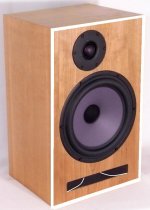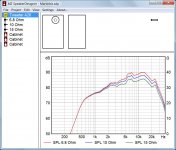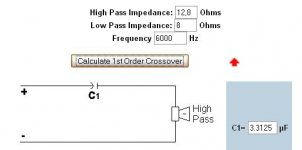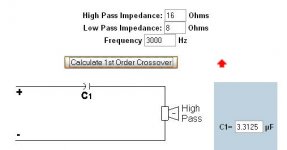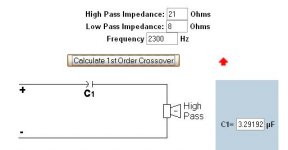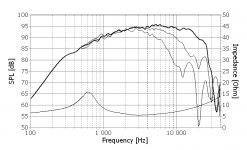Ehm, nobody? Really, I find this question to be of general interest, not only related to this very speaker kit. Could it be true that the resistance of a tweeter (with or without series resistor) doesn't play such a big role concerning the predicted cossover frequency after all?
This would be new to me but very important to know!
Thanks!
Martin
This would be new to me but very important to know!
Thanks!
Martin
Good question....I don't know the answer. Feeding the value into a standard rc crossover calculator...the difference is indeed around 2000.
Hz.
If your really want an answer I would post the question in its own thread..currently the title probably attracts very little views.
Hz.
If your really want an answer I would post the question in its own thread..currently the title probably attracts very little views.
Last edited:
It is not really a port but an aperiodic slot.Maybe flare the ports
Could it be true that the resistance of a tweeter (with or without series resistor) doesn't play such a big role concerning the predicted cossover frequency after all?
This would be new to me but very important to know!
The resistor affects mainly the high frequency response of the tweeter and has little influence at the crossover frequency:
Attachments
Thanks a lot for the sim!
But the question remains the same: Why is that?
Example: Have a look at the attached pics below.
1. Tweeter + 6,8R, C1 = 3,3uF
2. Tweeter + 10R, C1 = 3,3uF
3. Tweeter + 15R, C1 = 3,3uF
Ignore the low pass impedance.
Now, have a look at the changing crossover frequency.
And compare this with the frequency response of the Seas kit...
But the question remains the same: Why is that?
Example: Have a look at the attached pics below.
1. Tweeter + 6,8R, C1 = 3,3uF
2. Tweeter + 10R, C1 = 3,3uF
3. Tweeter + 15R, C1 = 3,3uF
Ignore the low pass impedance.
Now, have a look at the changing crossover frequency.
And compare this with the frequency response of the Seas kit...
Attachments
The increase in resistance to be seen by the crossover should be usually reflected by a reduction in the cap value to retain the desired crossover frequency. However, adding a bigger resistor would pull the whole tweeter freq. response graph down, thus shifting effectively the crossover frequency so you may want to increase the cap to keep the crossover where it should be. 3.3uF is a small value, perhaps the change in resistors is compensated by retaining the cap value ( instead of reducing it to offset the higher impedance ) so crossover remains where it is supposed to be by the initial design.
But the question remains the same: Why is that?
Assuming a constant tweeter impedance of 6 ohm is an oversimplification. Actually the impedance is 8.5 ohm at 1000 Hz and 16 ohm at 600 Hz!
Attachments
Assuming a constant tweeter impedance of 6 ohm is an oversimplification. Actually the impedance is 8.5 ohm at 1000 Hz and 16 ohm at 600 Hz!
Yes, but in the range of the effective crossover frequency (according to Seas: around 3000 Hz) the impedance of this tweeter only varies from 6 to about 8 ohms. Over the whole range from, say, 2000 to 6000 Hz these variations can not be responsible for compensating these different loads the capacitor "sees".
Perhaps I should write to Seas about that. I don't want to make it overly complicated, but really, I don't get this, and I want to know because generally I like the sound of this particular crossover arrangement for a few suitable tweeters (e.g. Seas 27TDFC).
looking at the cabinet drawings from Seas. One thing they say is that "adding internal bracing to stiffen the cabinet is a good idea for the advanced builder and will further enhance performance". Not being an advanced builder I am wondering what internal bracing might look like? Any thoughts on this...
Yes, but in the range of the effective crossover frequency (according to Seas: around 3000 Hz) the impedance of this tweeter only varies from 6 to about 8 ohms. Over the whole range from, say, 2000 to 6000 Hz these variations can not be responsible for compensating these different loads the capacitor "sees".
Perhaps I should write to Seas about that. I don't want to make it overly complicated, but really, I don't get this, and I want to know because generally I like the sound of this particular crossover arrangement for a few suitable tweeters (e.g. Seas 27TDFC).
Martin, there is nothing wrong with your understanding of the formula. You are right about the effect of resistor to Fc. What you may not understand is the implication to the situation (LP slopes remain at 3000Hz, HP slope changes but is padded down, slope is very gentle at 6dB/octave, no drastic phase change, etc), which is not as severe as you might think.
Any news on this project?
I was also wondering if anybody has experiences with this particular Seas midbass driver. Perhaps it might be even better to mount them into a closed box of around 50l rather than using the suggested aperiodic design. One will need the space for larger speakers anyway, even with with the aperiodic version, standmounted.
Or is it possible that the suggested enclosure might actually sound better?
Another thing is that the 35mm dome mid-tweeter really is expensive. I have had very good results with the 27TFFC (H881), even with 1st order crossover. Perhaps this would be a suitable candidate. In direct comparison I found that the 27TFFC sounds a bit more "classy" than the 27TDFC, a bit more like a tweeter is supposed to sound, if you get my idea. I could imagine that this sound signature might go quite well with this classy paper cone midbass. I found the 27TFFC a bit more airy and sparkling in the high frequency range. Also, with a 1st order crossover (4,7uF) the 27TFFC seems to be a bit smoother on the ear in the lower midrange. But don't get me wrong: The 27TDFC is a very very good tweeter, too! It depends on the application and personal preferences which one is fitting the bill. (But I will write about this comparison later in the "27TFFC vs. 27TDFC"-thread.)
Martin
I was also wondering if anybody has experiences with this particular Seas midbass driver. Perhaps it might be even better to mount them into a closed box of around 50l rather than using the suggested aperiodic design. One will need the space for larger speakers anyway, even with with the aperiodic version, standmounted.
Or is it possible that the suggested enclosure might actually sound better?
Another thing is that the 35mm dome mid-tweeter really is expensive. I have had very good results with the 27TFFC (H881), even with 1st order crossover. Perhaps this would be a suitable candidate. In direct comparison I found that the 27TFFC sounds a bit more "classy" than the 27TDFC, a bit more like a tweeter is supposed to sound, if you get my idea. I could imagine that this sound signature might go quite well with this classy paper cone midbass. I found the 27TFFC a bit more airy and sparkling in the high frequency range. Also, with a 1st order crossover (4,7uF) the 27TFFC seems to be a bit smoother on the ear in the lower midrange. But don't get me wrong: The 27TDFC is a very very good tweeter, too! It depends on the application and personal preferences which one is fitting the bill. (But I will write about this comparison later in the "27TFFC vs. 27TDFC"-thread.)
Martin
Last edited:
Well on my side I finally ordered the 27TBFC/G to go with the A26Re4. I think these are a good match as they can easily handle low frequencies and remain quite linear.
I plan to build the cabinets when I'll have a free week-end in 10 days. I already have anything I need: speakers, birch multiply, damping material, crossover components... Of course I will post the building process here.
I just can't wait!
I plan to build the cabinets when I'll have a free week-end in 10 days. I already have anything I need: speakers, birch multiply, damping material, crossover components... Of course I will post the building process here.
I just can't wait!
Interesting!
Up to 10kHz the frequency response of the 27TBFC/G and 27TFFC is VERY similar, as well as the impedance plot.
Source:
H1212-06 27TBFC/G
and
H0881-06 27TFFC
Since the mechanical data is also identical, it would be easy to change one for the other (or even the 27TDFC) later on, even if flush mounted. These tweeters aren't expensive and are easy to sell so it would be a very interesting experiment trying out all these tweeters.
But of course, why don't I try it myself? I would, and I would want to, but recently I just build a pair of speakers (Vifa P17 & Seas 27TFFC) and I really would like to hear a bit about this kit from others before I decide to sell my speakers for the purpose of building a new pair. I don't have the money OR space to keep them all...
Regards!
Martin
Up to 10kHz the frequency response of the 27TBFC/G and 27TFFC is VERY similar, as well as the impedance plot.
Source:
H1212-06 27TBFC/G
and
H0881-06 27TFFC
Since the mechanical data is also identical, it would be easy to change one for the other (or even the 27TDFC) later on, even if flush mounted. These tweeters aren't expensive and are easy to sell so it would be a very interesting experiment trying out all these tweeters.
But of course, why don't I try it myself? I would, and I would want to, but recently I just build a pair of speakers (Vifa P17 & Seas 27TFFC) and I really would like to hear a bit about this kit from others before I decide to sell my speakers for the purpose of building a new pair. I don't have the money OR space to keep them all...
Regards!
Martin
I've listen to the A26 today at the store.
I really like them!
Coming from the full range community, (wide range single driver camp), I'm very sensitive to crossover distortion in the vocal range, but these guys was very good in that regard me thinks
The only thing I was missing was in the bass region. Although the bass was tight and good, I'm missing an octave downstairs. But, I think if one should build a bigger box that problem would be solved.
I love the retro look of it. Wide baffles rules
I really like them!
Coming from the full range community, (wide range single driver camp), I'm very sensitive to crossover distortion in the vocal range, but these guys was very good in that regard me thinks
The only thing I was missing was in the bass region. Although the bass was tight and good, I'm missing an octave downstairs. But, I think if one should build a bigger box that problem would be solved.
I love the retro look of it. Wide baffles rules
This week end I started the cabs' building. I was at a friend's workshop. He has an old Dove Tails machine (or I don't know how to call it in English). Despite a few dings here and there on the outer ply (that will be filled later), it is quite a precise jointing, looks pretty stable and beautiful IMO.
Here are a few pictures:
And on situation with the A26RE4 and the 27TBFC/G:
I still have some work for the next week-end though!
The tweeter here is not the T35 (a bit costy) but a 27TBFC/G, owing its nice behaviour in lowest frequencies (down to 1.5 kHz) and a very good linearity up to 20 kHz; it has also less directivity than the T35. It will be crossed at 2 kHz like the T35, but with a lower serie resistor owing it's better sensitivity.
Here are a few pictures:
An externally hosted image should be here but it was not working when we last tested it.
An externally hosted image should be here but it was not working when we last tested it.
And on situation with the A26RE4 and the 27TBFC/G:
An externally hosted image should be here but it was not working when we last tested it.
An externally hosted image should be here but it was not working when we last tested it.
I still have some work for the next week-end though!
The tweeter here is not the T35 (a bit costy) but a 27TBFC/G, owing its nice behaviour in lowest frequencies (down to 1.5 kHz) and a very good linearity up to 20 kHz; it has also less directivity than the T35. It will be crossed at 2 kHz like the T35, but with a lower serie resistor owing it's better sensitivity.
Looks nice!
27 series just might do this low xo, but I guess you will get a little dip in response somewhere 1-1,5kHz and perhaps some phase mismatch there, because of driver's faster roll-off. I had same tweeters in my Zaph L18's and they are very fast and have a bit "bite" in the highest highs. T35 might give a more classical "soft - typical paper/cloth" sound. It is easy to invest a little more later on if you want...
I find this as a wonderful "retro" speaker. A closed box might be just perfect if you place them in a small room. The Madisound Speaker Store
27 series just might do this low xo, but I guess you will get a little dip in response somewhere 1-1,5kHz and perhaps some phase mismatch there, because of driver's faster roll-off. I had same tweeters in my Zaph L18's and they are very fast and have a bit "bite" in the highest highs. T35 might give a more classical "soft - typical paper/cloth" sound. It is easy to invest a little more later on if you want...
I find this as a wonderful "retro" speaker. A closed box might be just perfect if you place them in a small room. The Madisound Speaker Store
- Home
- Loudspeakers
- Multi-Way
- SEAS A26 Speaker Kit

